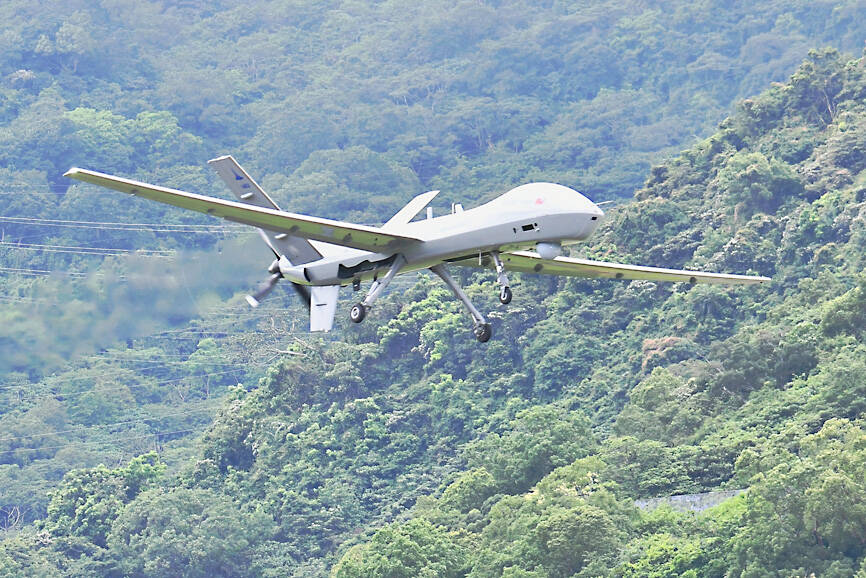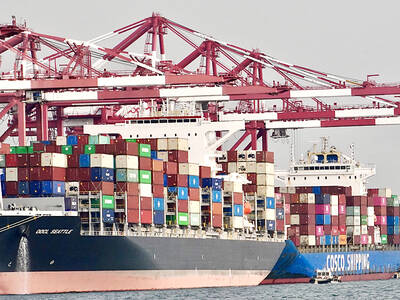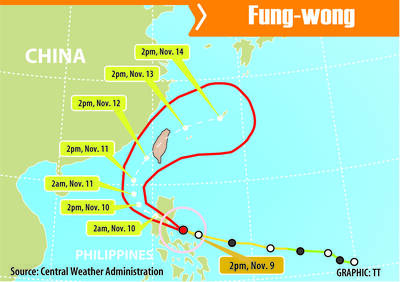Taiwan reached another defense milestone after the domestically developed Teng Yun 2 drone stayed airborne for more than 20 hours during its most recent test flight, a source said yesterday.
The drone broke its first record in June last year when it flew for 10 hours straight, following the entire perimeter of Taiwan’s air defense identification zone.
The new 20-hour record means that the drone could be used to monitor the Taiwan Strait for nearly an entire day at a time, the source said.

Photo: Yu Tai-lang, Taipei Times
Designed by the Chungshan Institute of Science and Technology, the Teng Yun 2, or “Cloud Rider 2” (騰雲二型), can operate day and night in all weather conditions, and is capable of aerial image surveillance and reconnaissance, electronic parameter reconnaissance, electronic interference, meteorological observation and relaying signals.
The Teng Yun 2 is a large, long-endurance, satellite-guided, medium-altitude drone that can carry multiple payloads, meaning that it can be used for surveillance or strike missions, information from the institute showed.
It can also take off and land autonomously, and has multiple guidance and control links, as well as ground-networked communication links.
“During a combat scenario, the drone could provide remote, real-time surveillance information, and could play an important early warning role,” the source said.
The Teng Yun 2 is expected to be used by the military alongside US-made MQ-9 Reaper drones, with the Reapers being responsible for high-altitude surveillance and reconnaissance missions, and the Teng Yun 2 to be used for medium and low-altitude missions, the source said.
The drone’s capabilities would give the military more flexible and robust surveillance capabilities, they said.
“However, the number of drones that the air force will purchase is still undetermined, and that would affect how they are deployed,” the source said.
The Chinese military is also developing drones, which it hopes will strengthen its surveillance and reconnaissance capabilities, so Taiwan’s military must simultaneously surveil at different altitudes to give it an advantage, the source said.
In other military news, the Ministry of National Defense said that over the past 24 hours it had detected eight Chinese fighter jets crossing the median line of the Taiwan Strait, as well as one Chinese balloon.
The ministry said the Chinese J-10, J-11 and J-16 fighter jets had crossed the median line to the north and center of the Strait.
The median line once served as an unofficial barrier between the two sides, but Chinese planes now regularly fly over it.
Taiwan sent its own forces to monitor the fighter jets, the ministry said.
The ministry also reported another Chinese balloon in the Strait.
Taipei officials have said the balloons are most likely for monitoring the weather, and the spate of sightings could be due to the direction of winds.
The balloon was spotted after crossing the median line late on Saturday morning, 97 nautical miles (180km) northwest of Keelung at an altitude of approximately 6,100m, the ministry said, adding that it headed east and disappeared about an hour later.
The potential for China to use balloons for spying became a global issue in February when the US shot down what it said was a Chinese surveillance balloon. China said the balloon was a civilian craft that had accidentally drifted into the US.
Additional reporting by Reuters

The Central Weather Administration (CWA) yesterday said it expected to issue a sea warning for Typhoon Fung-Wong tomorrow, which it said would possibly make landfall near central Taiwan. As of 2am yesterday, Fung-Wong was about 1,760km southeast of Oluanpi (鵝鑾鼻), Taiwan’s southernmost point, moving west-northwest at 26kph. It is forecast to reach Luzon in the northern Philippines by tomorrow, the CWA said. After entering the South China Sea, Typhoon Fung-Wong is likely to turn northward toward Taiwan, CWA forecaster Chang Chun-yao (張峻堯) said, adding that it would likely make landfall near central Taiwan. The CWA expects to issue a land

Taiwan’s exports soared to an all-time high of US$61.8 billion last month, surging 49.7 percent from a year earlier, as the global frenzy for artificial intelligence (AI) applications and new consumer electronics powered shipments of high-tech goods, the Ministry of Finance said yesterday. It was the first time exports had exceeded the US$60 billion mark, fueled by the global boom in AI development that has significantly boosted Taiwanese companies across the international supply chain, Department of Statistics Director-General Beatrice Tsai (蔡美娜) told a media briefing. “There is a consensus among major AI players that the upcycle is still in its early stage,”

The Central Weather Administration (CWA) yesterday said it is expected to issue a sea warning for Typhoon Fung-wong this afternoon and a land warning tomorrow. As of 1pm, the storm was about 1,070km southeast of Oluanpi (鵝鑾鼻), Taiwan’s southernmost point, and was moving west-northwest at 28 to 32kph, according to CWA data. The storm had a radius of 250km, with maximum sustained winds of 173kph and gusts reaching 209kph, the CWA added. The storm is forecast to pass near Luzon in the Philippines before entering the South China Sea and potentially turning northward toward Taiwan, the CWA said. CWA forecaster Chang Chun-yao (張峻堯) said

‘SECRETS’: While saying China would not attack during his presidency, Donald Trump declined to say how Washington would respond if Beijing were to take military action US President Donald Trump said that China would not take military action against Taiwan while he is president, as the Chinese leaders “know the consequences.” Trump made the statement during an interview on CBS’ 60 Minutes program that aired on Sunday, a few days after his meeting with Chinese President Xi Jinping (習近平) in South Korea. “He [Xi] has openly said, and his people have openly said at meetings, ‘we would never do anything while President Trump is president,’ because they know the consequences,” Trump said in the interview. However, he repeatedly declined to say exactly how Washington would respond in